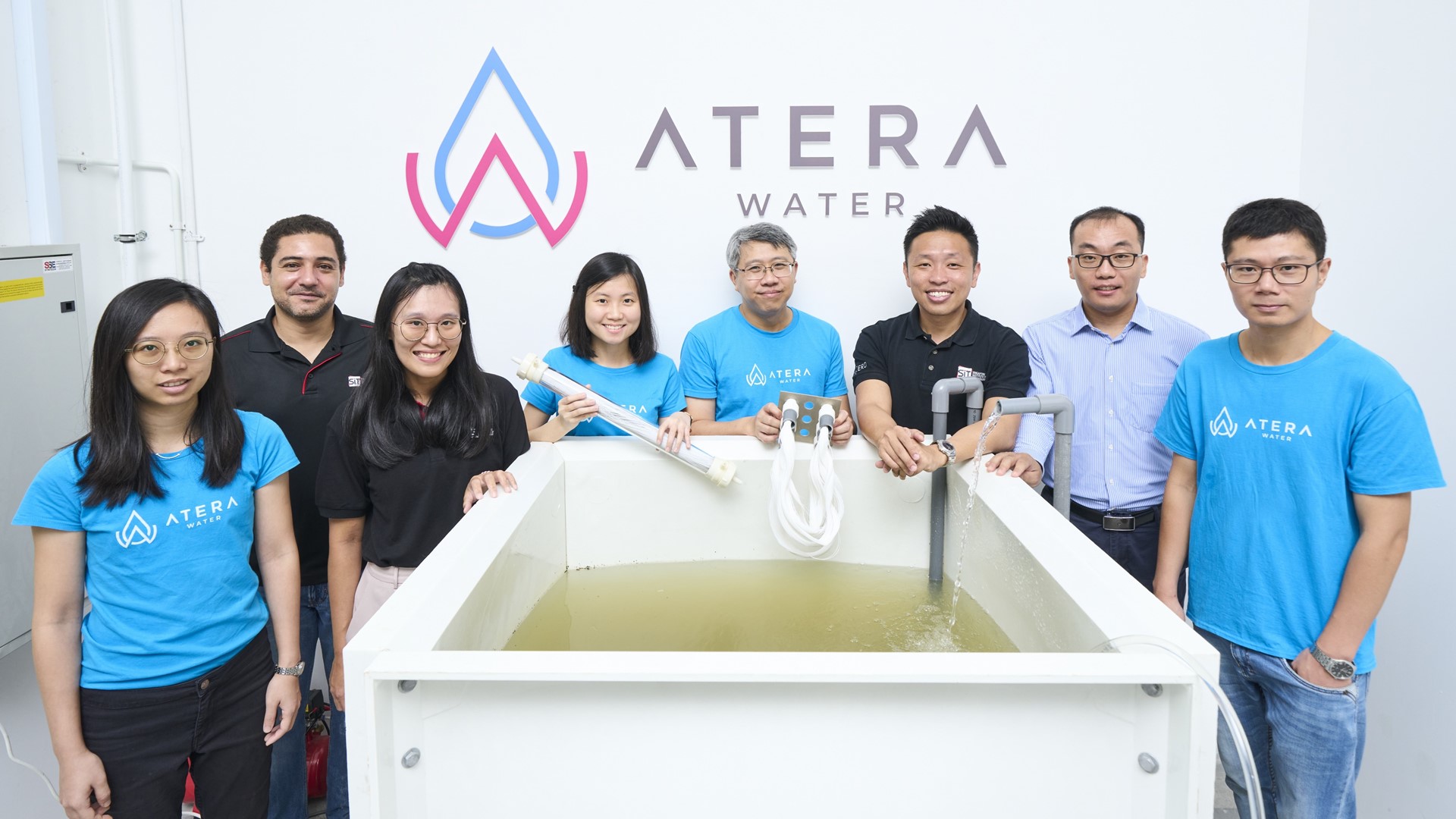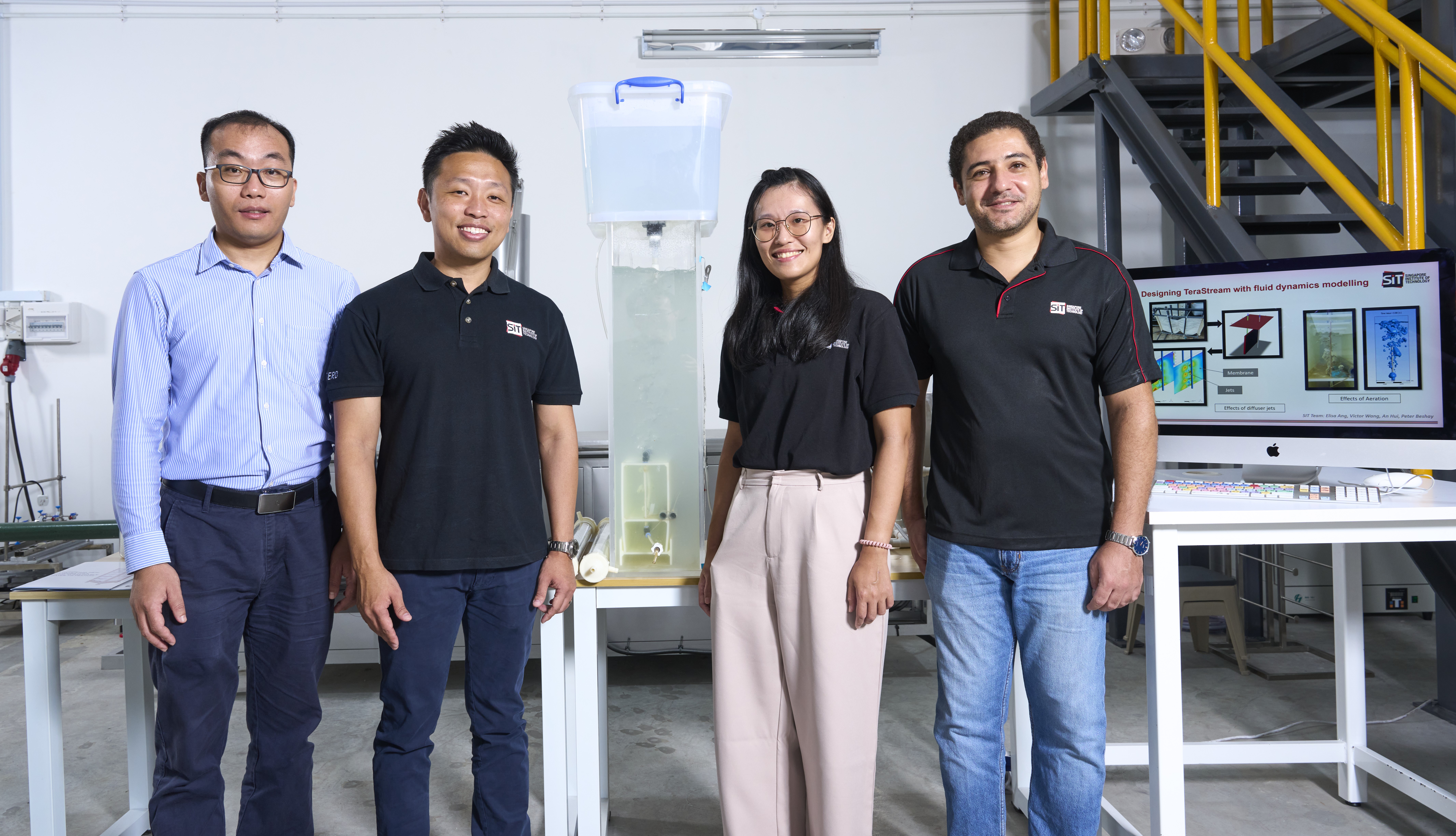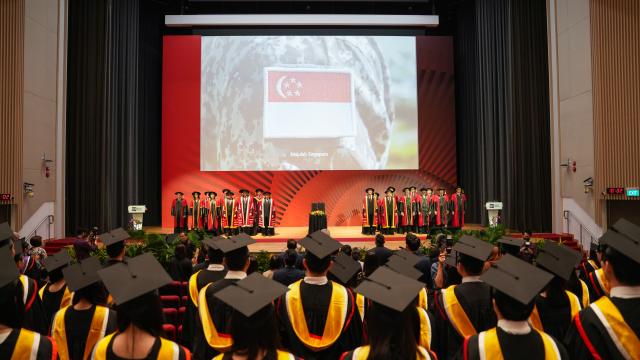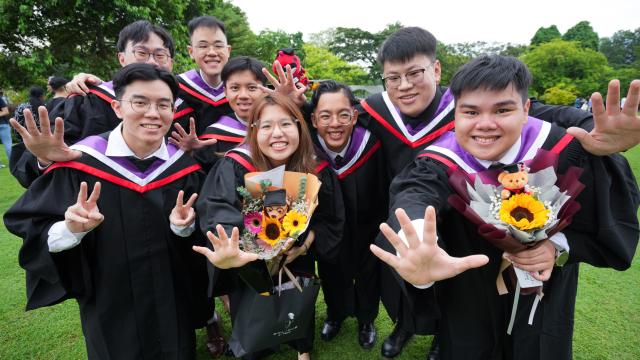
Representatives from SIT and Atera Water (from left): Ms Rachel Yap, Product Engineer, Atera Water; Dr Peter Beshay, Engineering Cluster, SIT; Assistant Professor Elisa Ang, Engineering Cluster, SIT; Ms Tai Kee, COO and Co-Founder, Atera Water; Dr Adrian Yeo, CEO and Co-Founder, Atera Water; Associate Professor Victor Wang, Engineering Cluster, SIT; Associate Professor An Hui, Engineering Cluster, SIT; and Dr Chen Xuelong, Senior Research Scientist, Atera Water. (SIT Photo: Keng Photography/Tan Eng Keng)
Local water tech start-up Atera Water and scientists from Nanyang Technological University, Singapore (NTU Singapore) and the Singapore Institute of Technology (SIT) have developed a new type of membrane-based water filtration system for large-scale clean water production that is more affordable.
In addition, the new system has only half the carbon footprint of conventional water treatment plants. This is made possible through an efficient nanocomposite membrane named CLARITY.
CLARITY is made from special nanoparticles combined with low-cost polymers such as polypropylene (PP), commonly used for plastic grocery bags. It is easier and more environmentally friendly to manufacture than the conventional polyvinylidene fluoride (PVDF) membranes used by developed countries.
While similar membranes made from PP are available in the market, they are usually only suitable for home use since they break easily when subjected to cleaning procedures in commercial plants.
However, with a new nanocomposite structure developed by NTU School of Materials Science and Engineering Professor Hu Xiao and the Atera Water team, CLARITY is estimated to be two to three times stronger than the other PP membranes in the market.
SIT and Atera Water then incorporated CLARITY membranes into an innovative water treatment system named TeraStream, which takes advantage of the increased robustness and lower cost.
PVDF membrane systems are currently too expensive to purchase and operate for communities in developing countries. Moreover, they require skilled labour due to sophisticated controls and tight operating ranges, which can be difficult to maintain outside of large cities.
Incorporating cutting-edge fluid dynamic modelling, Assistant Professor Elisa Ang, Associate Professor Victor Wang, Associate Professor An Hui, and Dr Peter Beshay from SIT’s Engineering Cluster worked with Atera Water closely to design TeraStream, enabling it to handle the challenging environments found in developing countries.
TeraStream aims to replace the rudimentary sand filter systems used in many regional countries such as Vietnam and Indonesia, says Atera Water CEO and Co-founder Dr Adrian Yeo, an NTU alumnus who received multiple awards for his water-related innovations that had great societal and community impact.
“These sand filters which used to work for the last century are now unable to purify the increasingly polluted water in the ground and rivers in many countries, due to reasons such as over-exploitation of water resources, climate change and pollution from industries,” explained Dr Yeo.
TeraStream was piloted in Vietnam from March to August 2023 and will be deployed in a 10,000m3/day water treatment facility in Ha Tinh Province in northeastern Vietnam. The amount of clean drinking water generated daily is the equivalent of four Olympic-sized swimming pools (50m x 25m x 2m).
A Letter of Intent (LOI) has been presented by Vietnamese water utility company HT Thanh Trung Co. Ltd. to Atera Water, for a contract to provide some 30,000 people with piped access to clean water.
“Ha Tinh is currently experiencing the effects of climate change, which has created water stress in the area. We have been searching for an invention that can sustainably produce water at a large scale – we are confident that we have found that in TeraStream. We are happy to collaborate with our Singaporean partners and look forward to deploying TeraStream in Ha Tinh as well as our other facilities,” said Mr Dinh Minh Dao, Chairman of HT Thanh Trung Co. Ltd.
Sustainability at its Core
The three partners share the same commitment to tackle the effects of climate change using sustainable solutions, so every facet of the TeraStream was designed with sustainability in mind.
“Prior to the establishment of Atera Water, when Dr Adrian Yeo approached me looking for a solution that can enhance the strength of polymeric membranes, I was excited about the potential where our materials science knowledge can be used to tackle one of humanity’s greatest challenges, which is providing access to clean and affordable drinking water – also one of [1]United Nation’s Sustainable Development Goals. The initial patents on the jointly developed technology were filed quickly, thanks to the strong technical know-how at NTU and pressing demand from the industry,” said Prof Hu, Programme Director of Sustainable Chemistry & Materials at NTU’s Nanyang Environment & Water Research Institute (NEWRI).
CLARITY membranes are made using a unique melt-stretching method requiring zero harsh chemicals. The PP polymer and nanoparticle compounds are combined during the process to make a straw-like hollow fibre structure that has a slit-like pore structure. Despite allowing water to pass through faster, the slits can still block up to 99.99 per cent of solid contaminants and microorganisms.
These nanoparticle compounds were specially selected with help from Prof Hu, who has pioneered sustainable ways to create new composite and hybrid materials.“To achieve sustainable clean water production, it is crucial to design a system that features a good flow of water and efficient use of energy,” said Asst Prof Ang, who led the SIT team.
“Our partnership with Atera Water represents the integration of translational research and real-world impact. At SIT, we have harnessed our applied research expertise to tackle the pressing challenges surrounding sustainable water production and achieved an outcome with the potential to forge a more sustainable and meaningful future in clean water production. This project also gives our students the opportunity to understand and participate in solving a real-world challenge,” said Asst Prof Ang.

SIT research team from the Engineering Cluster (from left), Associate Professor An Hui, Associate Professor Victor Wang, Assistant Professor Elisa Ang, and Dr Peter Beshay, with a lab-scale model of TeraStream. (SIT Photo: Keng Photography/Tan Eng Keng)
By carefully controlling the water flow – also known as hydrodynamics – within the system, TeraStream is able to operate at a low and stable water pressure, which can reduce chemical and electrical consumption by up to 90 per cent versus conventional systems. It also generates no sludge, which could potentially save up to 3,000 tons of carbon annually.
In comparison, conventional PVDF membrane systems are designed to operate at a higher water pressure, thus consuming significant amounts of electricity and chemicals to maintain. It requires frequent cleaning to remove contaminants, which forms waste sludge that needs to be treated and landfilled.
Additionally, the production of PVDF hollow-fibre membranes generates a large amount of waste chemical pollutants, which also need to be treated further before they can be discharged, resulting in a larger environmental impact and carbon footprint.
Singaporean Technology, Global Application
As a made-in-Singapore product, TeraStream will be manufactured in Atera Water’s facility in Jurong and it will be exported globally. It was first conceived by Dr Yeo and his co-founder Ms Tai Kee in 2022 during the COVID-19 pandemic and successfully piloted in Vietnam for six months earlier this year, which paved the way for the upcoming deployment.
The collaboration is well-aligned with the NTU 2025 Strategic Plan, where sustainability research is a key pillar, as the University aims to create impactful innovations that can tackle some of humanity’s greatest challenges.
“Sustainability is a key priority in SIT’s applied research pursuits, where we aim to support solutions aligned to the Singapore Green Plan 2030. As a University of Applied Learning, our research focuses on bridging the gap between discovery-driven research and application, to deliver impactful solutions to industry and provide our students with authentic learning opportunities. Our collaboration with Atera Water and NTU is a wonderful example of how we help to unlock the economic value of a technology platform through translational research,” said Associate Professor Susanna Leong, Vice President (Applied Research), SIT.
Chief Operating Officer of Atera Water, Ms Tai, added: “For many communities, they cannot afford the best-in-class water filtration systems due to high costs and yet their existing sand filters are failing. Can we provide better clean drinking water to communities in Southeast Asia at the same cost?”
“I believe our innovation can aid the millions of people in water-stressed countries, especially in the face of climate change. Coming from Singapore, which transformed from a nation facing water scarcity to a global water hub today, we want to take this water story further by using our technological expertise to bring affordable clean water to the rest of the world.”
[1] https://www.who.int/news-room/fact-sheets/detail/drinking-water
Atera Water is a visionary water technology company focused on addressing the world's water stress challenges, especially in climate-impacted regions. Originating from Singapore, a global water hub, Atera Water aims to close the gap between expensive, high-end filtration systems and less effective traditional methods like sand filters. Through their groundbreaking CLARITY membranes, they offer an affordable and effective solution for providing clean drinking water to communities in water-stressed countries. Atera Water is committed to using its technological expertise to pave the way for a future where clean, affordable water solutions are sustainably managed and widely accessible.
For more information visit : www.aterawater.com
A research-intensive public university, Nanyang Technological University, Singapore (NTU Singapore) has 33,000 undergraduate and postgraduate students in the Engineering, Business, Science, Medicine, Humanities, Arts, & Social Sciences, and Graduate colleges.
NTU is also home to world-renowned autonomous institutes – the National Institute of Education, S Rajaratnam School of International Studies, Earth Observatory of Singapore, and Singapore Centre for Environmental Life Sciences Engineering – and various leading research centres such as the Nanyang Environment & Water Research Institute (NEWRI) and Energy Research Institute @ NTU (ERI@N).
Under the NTU Smart Campus vision, the University harnesses the power of digital technology and tech-enabled solutions to support better learning and living experiences, the discovery of new knowledge, and the sustainability of resources.
Ranked amongst the world’s top universities, the University’s main campus is also frequently listed among the world’s most beautiful. Known for its sustainability, NTU has achieved 100% Green Mark Platinum certification for all its eligible building projects. Apart from its main campus, NTU also has a medical campus in Novena, Singapore’s healthcare district.
For more information, visit www.ntu.edu.sg
The Singapore Institute of Technology (SIT) is Singapore’s first University of Applied Learning, offering industry-relevant degree programmes that prepare its graduates to be work- and future-ready professionals. Its mission is to maximise the potential of its learners and to innovate with industry, through an integrated applied learning and research approach, so as to contribute to the economy and society.
The University’s unique pedagogy integrates work and study, embracing authentic learning in a real-world environment through collaborations with key strategic partners. Its focus on applied research with business impact is aimed at helping industry innovate and grow. Targeted to be ready in 2024, SIT’s centralised campus within the larger Punggol Digital District will feature a vibrant learning environment where academia and industry will be tightly integrated with the community.
For more information, visit www.SingaporeTech.edu.sg.















![[FA] SIT One SITizen Alumni Initiative_Web banner_1244px x 688px.jpg](/sites/default/files/2024-12/%5BFA%5D%20%20SIT%20One%20SITizen%20Alumni%20Initiative_Web%20banner_1244px%20x%20688px.jpg)


